Analyzing Leadership, Structure, and Culture in HSC Organizations
VerifiedAdded on 2020/01/28
|19
|4038
|176
Report
AI Summary
This report analyzes the influences on health and social care (HSC) organizations, focusing on Voluntary Service Overseas (VSO) as a case study. It examines different organizational structures like functional, divisional, and matrix structures, comparing and contrasting their impacts on service delivery. The report also explores organizational culture, including clan, adhocracy, market, and hierarchical cultures, and their effects on employee behavior and service quality. Furthermore, it discusses individual and group behavior theories like Maslow's Hierarchy of Needs and Tuckman's Stages of Group Development and how they are applicable in the HSC context. Finally, the report delves into leadership concepts, such as transformational, participative, and autocratic leadership, and their influence on the effectiveness of HSC organizations, emphasizing how leadership styles can impact volunteer motivation, staff morale, and overall service delivery. The report concludes by highlighting the interconnectedness of organizational structure, culture, and leadership in achieving optimal outcomes for health and social care services.
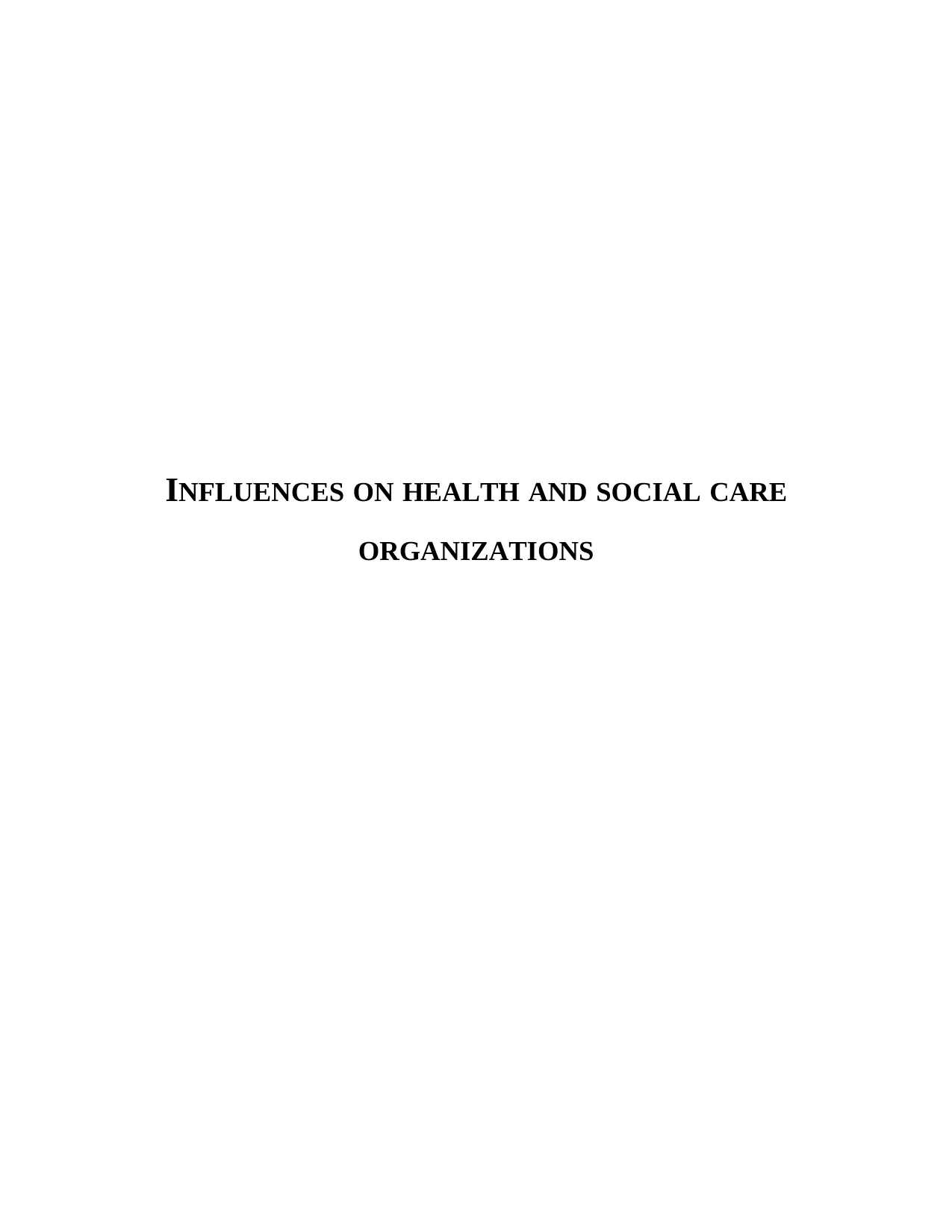
INFLUENCES ON HEALTH AND SOCIAL CARE
ORGANIZATIONS
ORGANIZATIONS
Paraphrase This Document
Need a fresh take? Get an instant paraphrase of this document with our AI Paraphraser
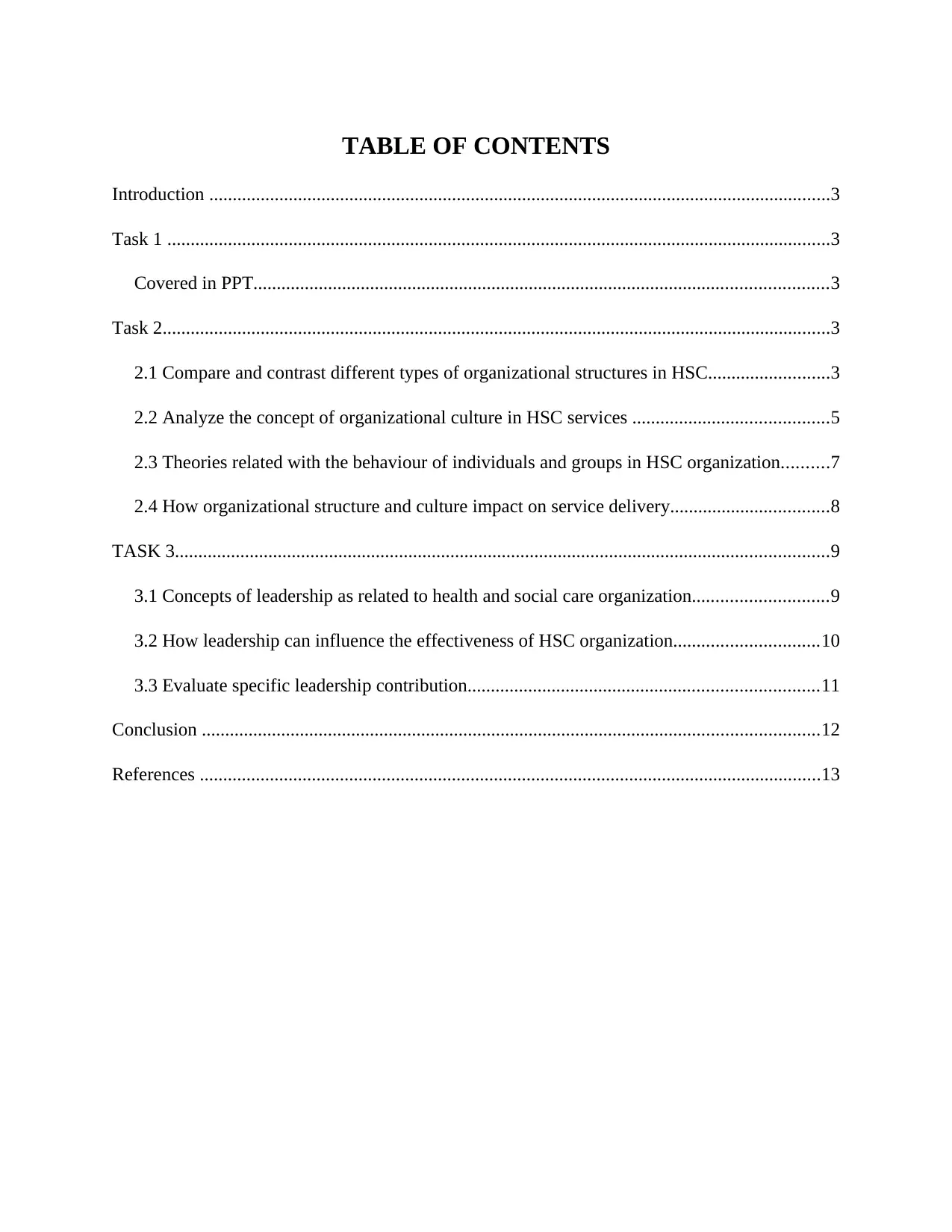
TABLE OF CONTENTS
Introduction .....................................................................................................................................3
Task 1 ..............................................................................................................................................3
Covered in PPT...........................................................................................................................3
Task 2...............................................................................................................................................3
2.1 Compare and contrast different types of organizational structures in HSC..........................3
2.2 Analyze the concept of organizational culture in HSC services ..........................................5
2.3 Theories related with the behaviour of individuals and groups in HSC organization..........7
2.4 How organizational structure and culture impact on service delivery..................................8
TASK 3............................................................................................................................................9
3.1 Concepts of leadership as related to health and social care organization.............................9
3.2 How leadership can influence the effectiveness of HSC organization...............................10
3.3 Evaluate specific leadership contribution...........................................................................11
Conclusion ....................................................................................................................................12
References .....................................................................................................................................13
Introduction .....................................................................................................................................3
Task 1 ..............................................................................................................................................3
Covered in PPT...........................................................................................................................3
Task 2...............................................................................................................................................3
2.1 Compare and contrast different types of organizational structures in HSC..........................3
2.2 Analyze the concept of organizational culture in HSC services ..........................................5
2.3 Theories related with the behaviour of individuals and groups in HSC organization..........7
2.4 How organizational structure and culture impact on service delivery..................................8
TASK 3............................................................................................................................................9
3.1 Concepts of leadership as related to health and social care organization.............................9
3.2 How leadership can influence the effectiveness of HSC organization...............................10
3.3 Evaluate specific leadership contribution...........................................................................11
Conclusion ....................................................................................................................................12
References .....................................................................................................................................13
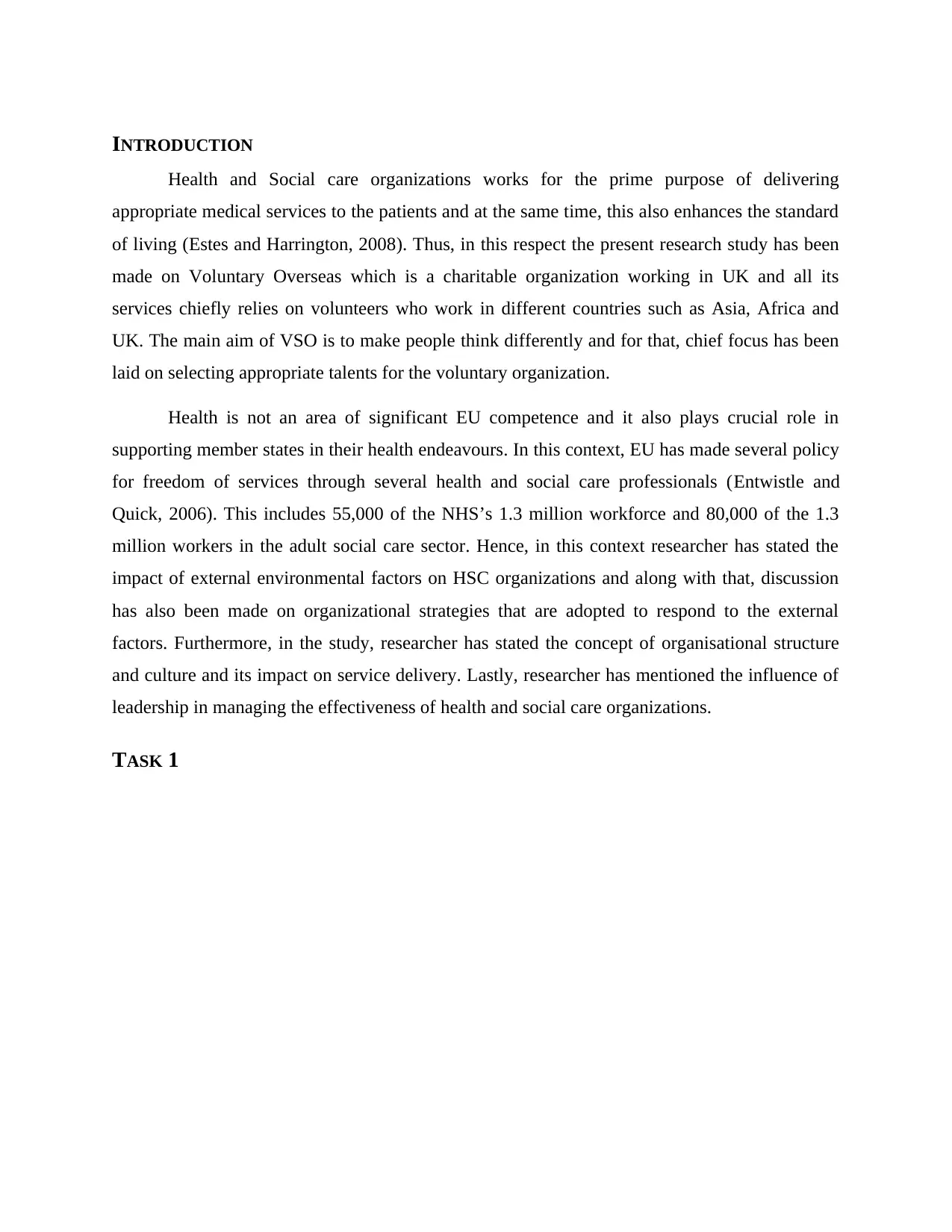
INTRODUCTION
Health and Social care organizations works for the prime purpose of delivering
appropriate medical services to the patients and at the same time, this also enhances the standard
of living (Estes and Harrington, 2008). Thus, in this respect the present research study has been
made on Voluntary Overseas which is a charitable organization working in UK and all its
services chiefly relies on volunteers who work in different countries such as Asia, Africa and
UK. The main aim of VSO is to make people think differently and for that, chief focus has been
laid on selecting appropriate talents for the voluntary organization.
Health is not an area of significant EU competence and it also plays crucial role in
supporting member states in their health endeavours. In this context, EU has made several policy
for freedom of services through several health and social care professionals (Entwistle and
Quick, 2006). This includes 55,000 of the NHS’s 1.3 million workforce and 80,000 of the 1.3
million workers in the adult social care sector. Hence, in this context researcher has stated the
impact of external environmental factors on HSC organizations and along with that, discussion
has also been made on organizational strategies that are adopted to respond to the external
factors. Furthermore, in the study, researcher has stated the concept of organisational structure
and culture and its impact on service delivery. Lastly, researcher has mentioned the influence of
leadership in managing the effectiveness of health and social care organizations.
TASK 1
Health and Social care organizations works for the prime purpose of delivering
appropriate medical services to the patients and at the same time, this also enhances the standard
of living (Estes and Harrington, 2008). Thus, in this respect the present research study has been
made on Voluntary Overseas which is a charitable organization working in UK and all its
services chiefly relies on volunteers who work in different countries such as Asia, Africa and
UK. The main aim of VSO is to make people think differently and for that, chief focus has been
laid on selecting appropriate talents for the voluntary organization.
Health is not an area of significant EU competence and it also plays crucial role in
supporting member states in their health endeavours. In this context, EU has made several policy
for freedom of services through several health and social care professionals (Entwistle and
Quick, 2006). This includes 55,000 of the NHS’s 1.3 million workforce and 80,000 of the 1.3
million workers in the adult social care sector. Hence, in this context researcher has stated the
impact of external environmental factors on HSC organizations and along with that, discussion
has also been made on organizational strategies that are adopted to respond to the external
factors. Furthermore, in the study, researcher has stated the concept of organisational structure
and culture and its impact on service delivery. Lastly, researcher has mentioned the influence of
leadership in managing the effectiveness of health and social care organizations.
TASK 1
⊘ This is a preview!⊘
Do you want full access?
Subscribe today to unlock all pages.

Trusted by 1+ million students worldwide

Paraphrase This Document
Need a fresh take? Get an instant paraphrase of this document with our AI Paraphraser

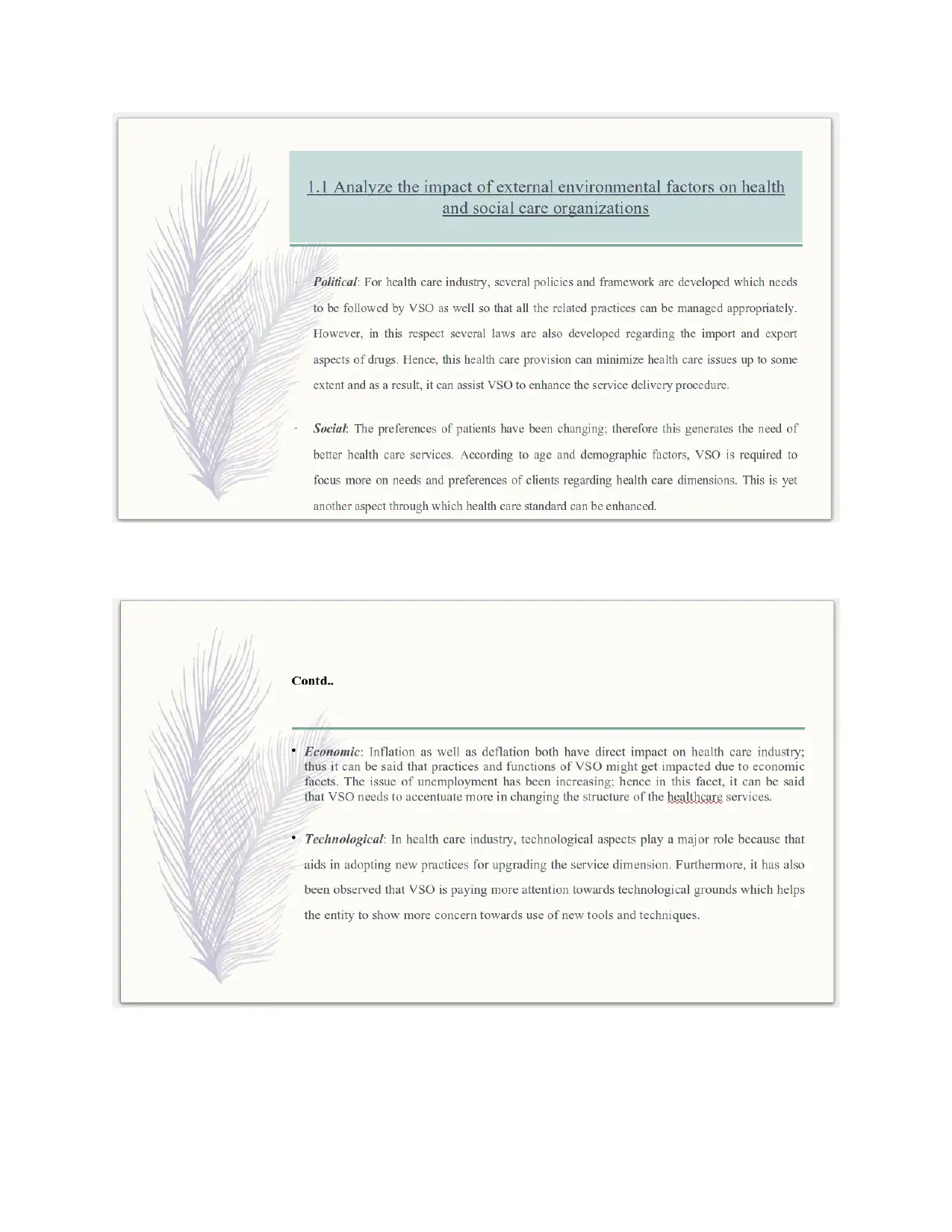
⊘ This is a preview!⊘
Do you want full access?
Subscribe today to unlock all pages.

Trusted by 1+ million students worldwide
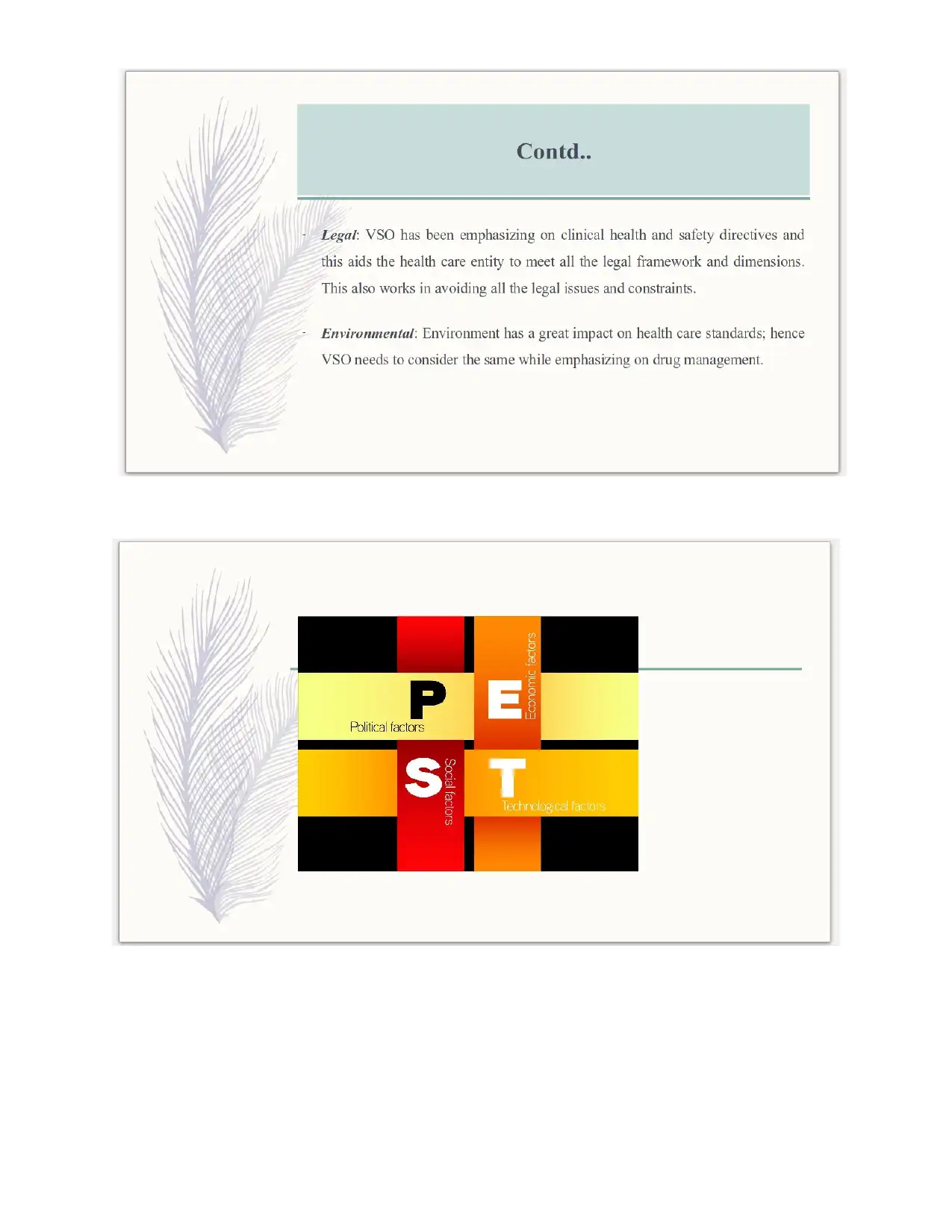
Paraphrase This Document
Need a fresh take? Get an instant paraphrase of this document with our AI Paraphraser
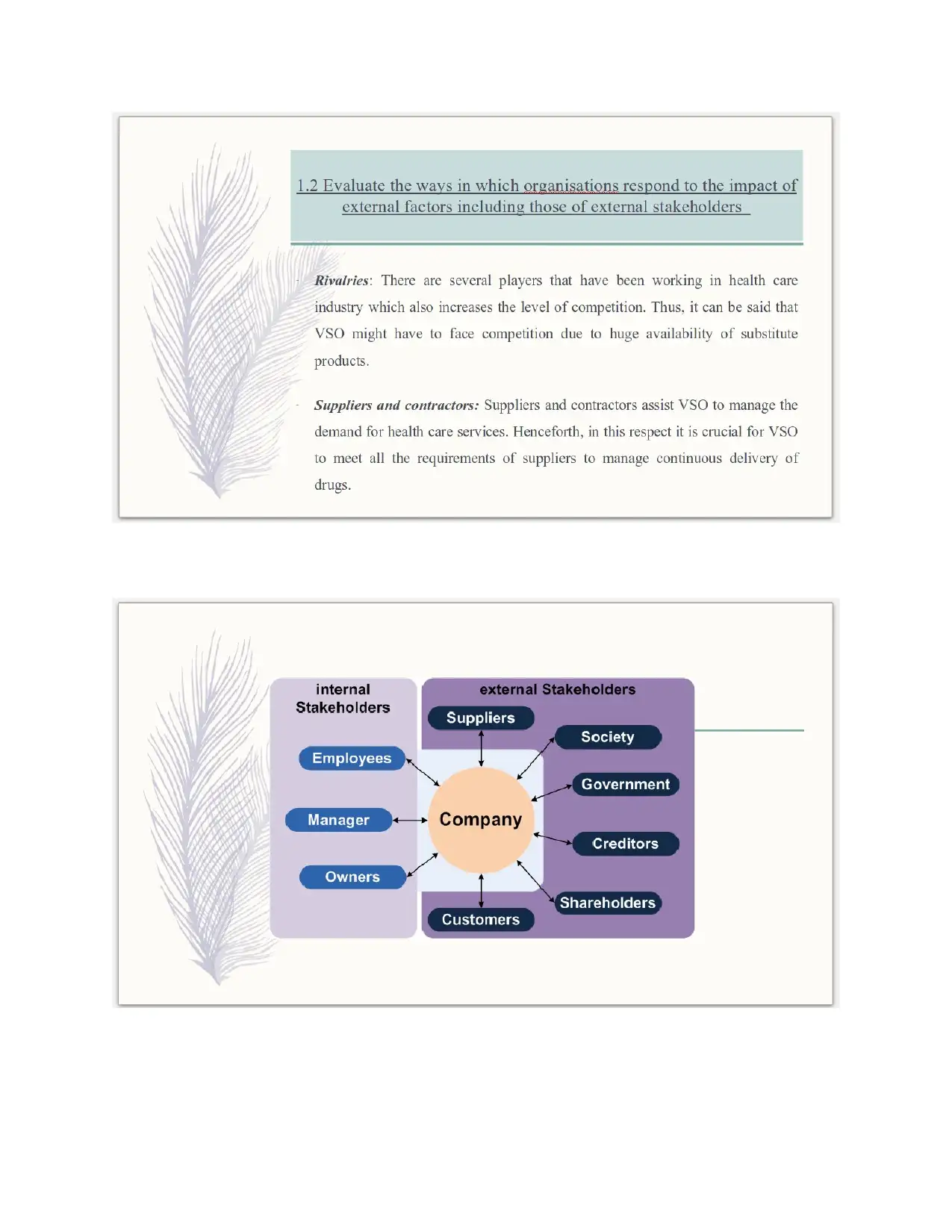
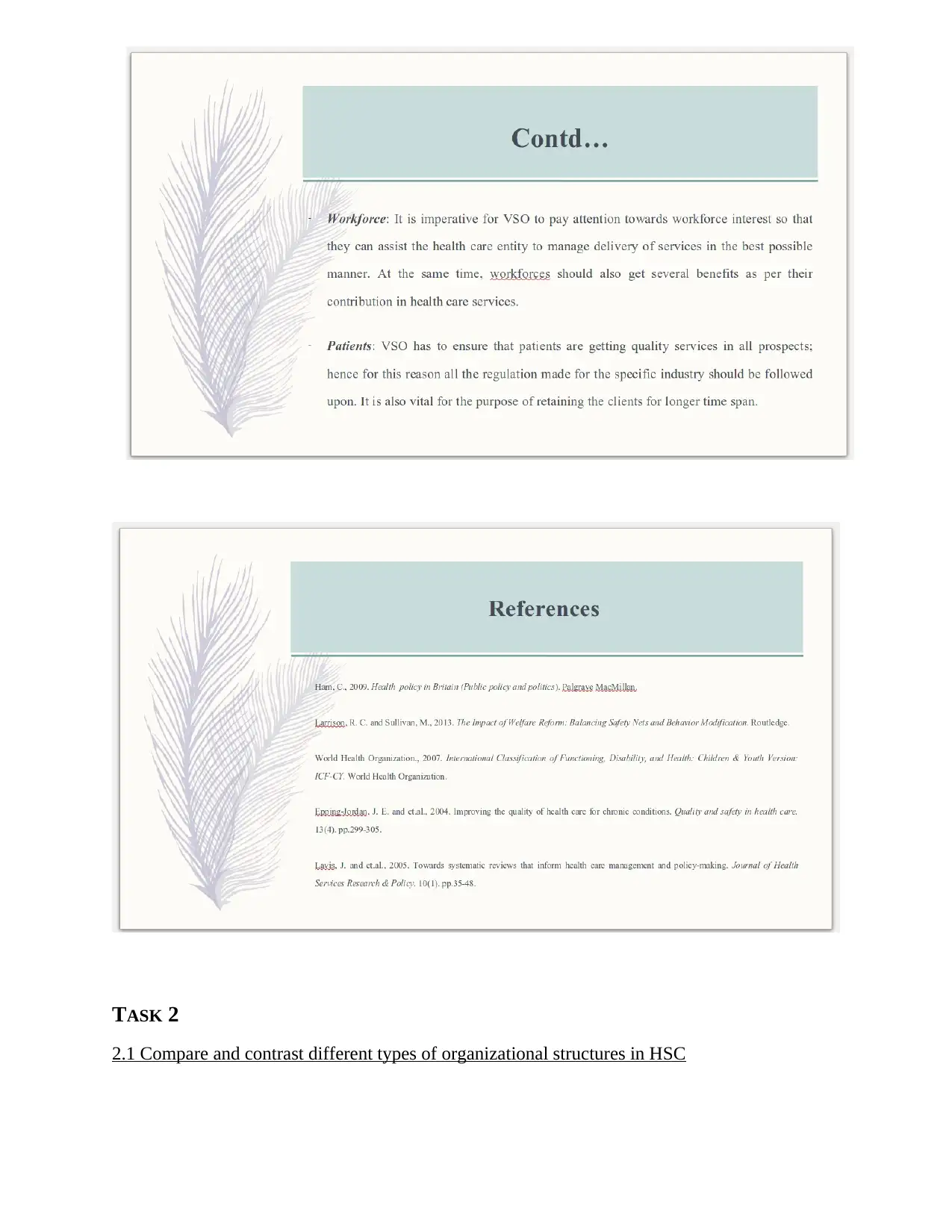
TASK 2
2.1 Compare and contrast different types of organizational structures in HSC
2.1 Compare and contrast different types of organizational structures in HSC
⊘ This is a preview!⊘
Do you want full access?
Subscribe today to unlock all pages.

Trusted by 1+ million students worldwide
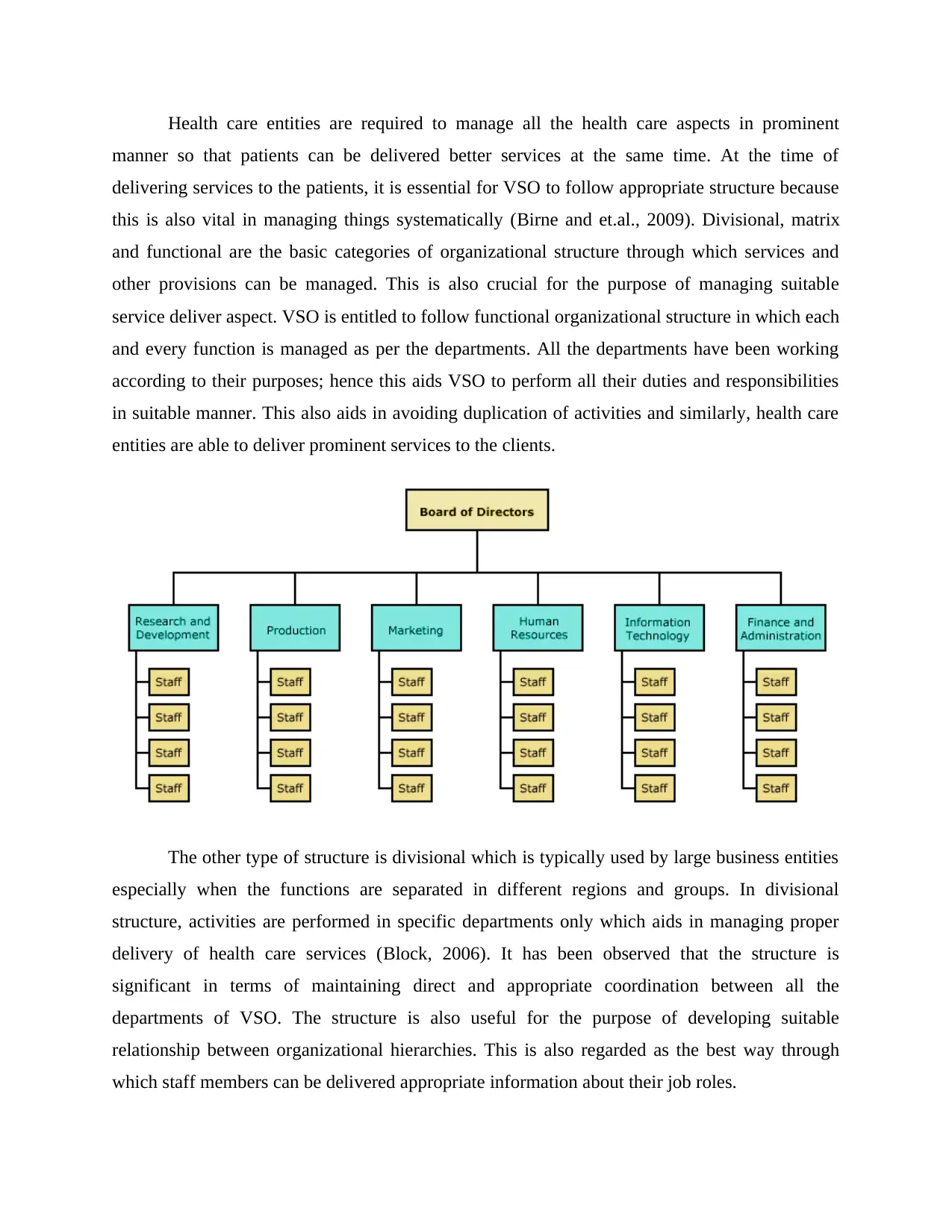
Health care entities are required to manage all the health care aspects in prominent
manner so that patients can be delivered better services at the same time. At the time of
delivering services to the patients, it is essential for VSO to follow appropriate structure because
this is also vital in managing things systematically (Birne and et.al., 2009). Divisional, matrix
and functional are the basic categories of organizational structure through which services and
other provisions can be managed. This is also crucial for the purpose of managing suitable
service deliver aspect. VSO is entitled to follow functional organizational structure in which each
and every function is managed as per the departments. All the departments have been working
according to their purposes; hence this aids VSO to perform all their duties and responsibilities
in suitable manner. This also aids in avoiding duplication of activities and similarly, health care
entities are able to deliver prominent services to the clients.
The other type of structure is divisional which is typically used by large business entities
especially when the functions are separated in different regions and groups. In divisional
structure, activities are performed in specific departments only which aids in managing proper
delivery of health care services (Block, 2006). It has been observed that the structure is
significant in terms of maintaining direct and appropriate coordination between all the
departments of VSO. The structure is also useful for the purpose of developing suitable
relationship between organizational hierarchies. This is also regarded as the best way through
which staff members can be delivered appropriate information about their job roles.
manner so that patients can be delivered better services at the same time. At the time of
delivering services to the patients, it is essential for VSO to follow appropriate structure because
this is also vital in managing things systematically (Birne and et.al., 2009). Divisional, matrix
and functional are the basic categories of organizational structure through which services and
other provisions can be managed. This is also crucial for the purpose of managing suitable
service deliver aspect. VSO is entitled to follow functional organizational structure in which each
and every function is managed as per the departments. All the departments have been working
according to their purposes; hence this aids VSO to perform all their duties and responsibilities
in suitable manner. This also aids in avoiding duplication of activities and similarly, health care
entities are able to deliver prominent services to the clients.
The other type of structure is divisional which is typically used by large business entities
especially when the functions are separated in different regions and groups. In divisional
structure, activities are performed in specific departments only which aids in managing proper
delivery of health care services (Block, 2006). It has been observed that the structure is
significant in terms of maintaining direct and appropriate coordination between all the
departments of VSO. The structure is also useful for the purpose of developing suitable
relationship between organizational hierarchies. This is also regarded as the best way through
which staff members can be delivered appropriate information about their job roles.
Paraphrase This Document
Need a fresh take? Get an instant paraphrase of this document with our AI Paraphraser
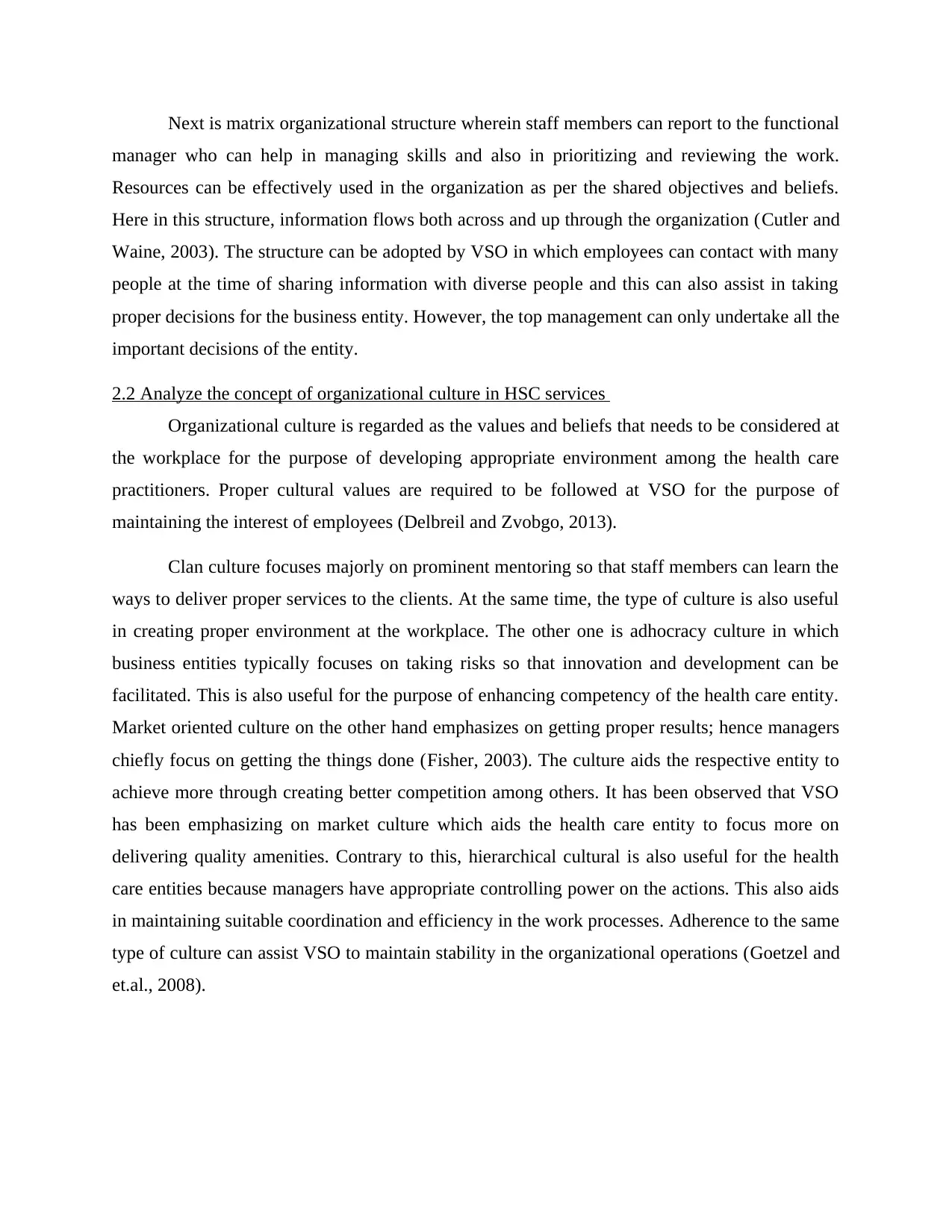
Next is matrix organizational structure wherein staff members can report to the functional
manager who can help in managing skills and also in prioritizing and reviewing the work.
Resources can be effectively used in the organization as per the shared objectives and beliefs.
Here in this structure, information flows both across and up through the organization (Cutler and
Waine, 2003). The structure can be adopted by VSO in which employees can contact with many
people at the time of sharing information with diverse people and this can also assist in taking
proper decisions for the business entity. However, the top management can only undertake all the
important decisions of the entity.
2.2 Analyze the concept of organizational culture in HSC services
Organizational culture is regarded as the values and beliefs that needs to be considered at
the workplace for the purpose of developing appropriate environment among the health care
practitioners. Proper cultural values are required to be followed at VSO for the purpose of
maintaining the interest of employees (Delbreil and Zvobgo, 2013).
Clan culture focuses majorly on prominent mentoring so that staff members can learn the
ways to deliver proper services to the clients. At the same time, the type of culture is also useful
in creating proper environment at the workplace. The other one is adhocracy culture in which
business entities typically focuses on taking risks so that innovation and development can be
facilitated. This is also useful for the purpose of enhancing competency of the health care entity.
Market oriented culture on the other hand emphasizes on getting proper results; hence managers
chiefly focus on getting the things done (Fisher, 2003). The culture aids the respective entity to
achieve more through creating better competition among others. It has been observed that VSO
has been emphasizing on market culture which aids the health care entity to focus more on
delivering quality amenities. Contrary to this, hierarchical cultural is also useful for the health
care entities because managers have appropriate controlling power on the actions. This also aids
in maintaining suitable coordination and efficiency in the work processes. Adherence to the same
type of culture can assist VSO to maintain stability in the organizational operations (Goetzel and
et.al., 2008).
manager who can help in managing skills and also in prioritizing and reviewing the work.
Resources can be effectively used in the organization as per the shared objectives and beliefs.
Here in this structure, information flows both across and up through the organization (Cutler and
Waine, 2003). The structure can be adopted by VSO in which employees can contact with many
people at the time of sharing information with diverse people and this can also assist in taking
proper decisions for the business entity. However, the top management can only undertake all the
important decisions of the entity.
2.2 Analyze the concept of organizational culture in HSC services
Organizational culture is regarded as the values and beliefs that needs to be considered at
the workplace for the purpose of developing appropriate environment among the health care
practitioners. Proper cultural values are required to be followed at VSO for the purpose of
maintaining the interest of employees (Delbreil and Zvobgo, 2013).
Clan culture focuses majorly on prominent mentoring so that staff members can learn the
ways to deliver proper services to the clients. At the same time, the type of culture is also useful
in creating proper environment at the workplace. The other one is adhocracy culture in which
business entities typically focuses on taking risks so that innovation and development can be
facilitated. This is also useful for the purpose of enhancing competency of the health care entity.
Market oriented culture on the other hand emphasizes on getting proper results; hence managers
chiefly focus on getting the things done (Fisher, 2003). The culture aids the respective entity to
achieve more through creating better competition among others. It has been observed that VSO
has been emphasizing on market culture which aids the health care entity to focus more on
delivering quality amenities. Contrary to this, hierarchical cultural is also useful for the health
care entities because managers have appropriate controlling power on the actions. This also aids
in maintaining suitable coordination and efficiency in the work processes. Adherence to the same
type of culture can assist VSO to maintain stability in the organizational operations (Goetzel and
et.al., 2008).
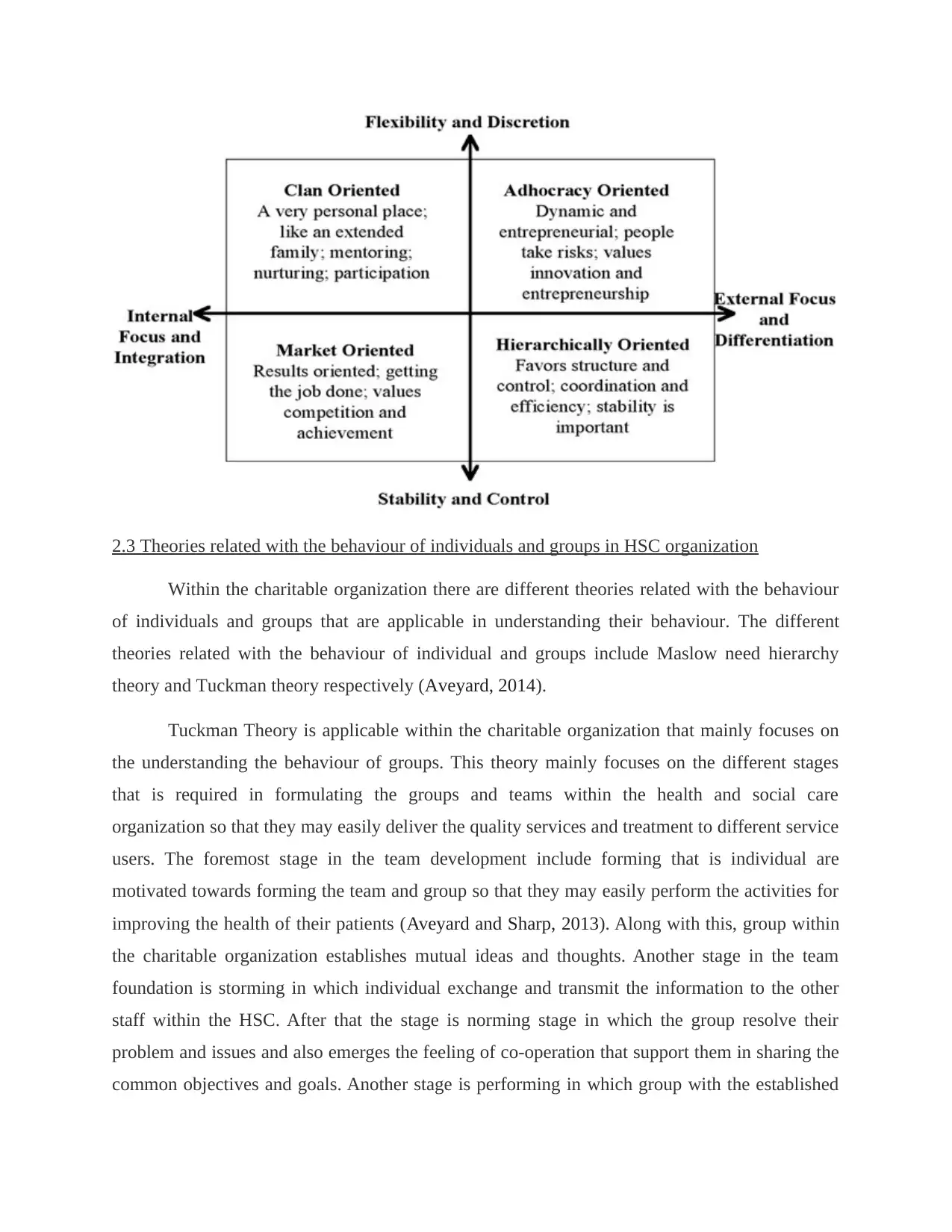
2.3 Theories related with the behaviour of individuals and groups in HSC organization
Within the charitable organization there are different theories related with the behaviour
of individuals and groups that are applicable in understanding their behaviour. The different
theories related with the behaviour of individual and groups include Maslow need hierarchy
theory and Tuckman theory respectively (Aveyard, 2014).
Tuckman Theory is applicable within the charitable organization that mainly focuses on
the understanding the behaviour of groups. This theory mainly focuses on the different stages
that is required in formulating the groups and teams within the health and social care
organization so that they may easily deliver the quality services and treatment to different service
users. The foremost stage in the team development include forming that is individual are
motivated towards forming the team and group so that they may easily perform the activities for
improving the health of their patients (Aveyard and Sharp, 2013). Along with this, group within
the charitable organization establishes mutual ideas and thoughts. Another stage in the team
foundation is storming in which individual exchange and transmit the information to the other
staff within the HSC. After that the stage is norming stage in which the group resolve their
problem and issues and also emerges the feeling of co-operation that support them in sharing the
common objectives and goals. Another stage is performing in which group with the established
Within the charitable organization there are different theories related with the behaviour
of individuals and groups that are applicable in understanding their behaviour. The different
theories related with the behaviour of individual and groups include Maslow need hierarchy
theory and Tuckman theory respectively (Aveyard, 2014).
Tuckman Theory is applicable within the charitable organization that mainly focuses on
the understanding the behaviour of groups. This theory mainly focuses on the different stages
that is required in formulating the groups and teams within the health and social care
organization so that they may easily deliver the quality services and treatment to different service
users. The foremost stage in the team development include forming that is individual are
motivated towards forming the team and group so that they may easily perform the activities for
improving the health of their patients (Aveyard and Sharp, 2013). Along with this, group within
the charitable organization establishes mutual ideas and thoughts. Another stage in the team
foundation is storming in which individual exchange and transmit the information to the other
staff within the HSC. After that the stage is norming stage in which the group resolve their
problem and issues and also emerges the feeling of co-operation that support them in sharing the
common objectives and goals. Another stage is performing in which group with the established
⊘ This is a preview!⊘
Do you want full access?
Subscribe today to unlock all pages.

Trusted by 1+ million students worldwide
1 out of 19
Related Documents
Your All-in-One AI-Powered Toolkit for Academic Success.
+13062052269
info@desklib.com
Available 24*7 on WhatsApp / Email
![[object Object]](/_next/static/media/star-bottom.7253800d.svg)
Unlock your academic potential
Copyright © 2020–2025 A2Z Services. All Rights Reserved. Developed and managed by ZUCOL.





